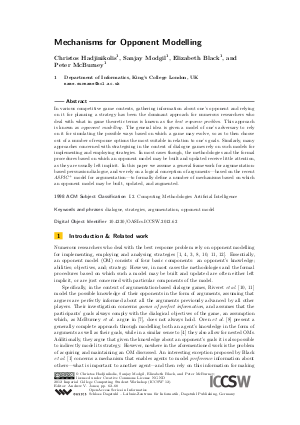Mechanisms for Opponent Modelling
Authors Christos Hadjinikolis, Sanjay Modgil, Elizabeth Black, Peter McBurney
-
Part of:
Volume:
2012 Imperial College Computing Student Workshop (ICCSW 2012)
Part of: Series: Open Access Series in Informatics (OASIcs) - License:
 Creative Commons Attribution-NonCommercial-NoDerivs 3.0 Unported license
Creative Commons Attribution-NonCommercial-NoDerivs 3.0 Unported license
- Publication Date: 2012-11-09
File

PDF
OASIcs.ICCSW.2012.62.pdf
- Filesize: 1.18 MB
- 7 pages
Document Identifiers
Subject Classification
Keywords
- dialogue
- strategies
- argumentation
- opponent model
Metrics
- Access Statistics
-
Total Accesses (updated on a weekly basis)
0PDF Downloads0Metadata Views
Abstract
In various competitive game contexts, gathering information about one's opponent and relying on it for planning a strategy has been the dominant approach for numerous researchers who deal with what in game theoretic terms is known as the best response problem. This approach is known as opponent modelling. The general idea is given a model of one's adversary to rely on it for simulating the possible ways based on which a game may evolve, so as to then choose out of a number of response options the most suitable~in relation to one's goals. Similarly, many approaches concerned with strategising in the context of dialogue games rely on such models for implementing and employing strategies. In most cases though, the methodologies and the formal procedures based on which an opponent model may be built and updated receive little attention, as they are usually left implicit. In this paper we assume a general framework for argumentation-based persuasion dialogue, and we rely on a logical conception of arguments - based on the recent ASPIC^+ model for argumentation - to formally define a number of mechanisms based on which an opponent model may be built, updated, and augmented.
Cite As Get BibTex
Christos Hadjinikolis, Sanjay Modgil, Elizabeth Black, and Peter McBurney. Mechanisms for Opponent Modelling. In 2012 Imperial College Computing Student Workshop. Open Access Series in Informatics (OASIcs), Volume 28, pp. 62-68, Schloss Dagstuhl – Leibniz-Zentrum für Informatik (2012)
https://doi.org/10.4230/OASIcs.ICCSW.2012.62
BibTex
@InProceedings{hadjinikolis_et_al:OASIcs.ICCSW.2012.62,
author = {Hadjinikolis, Christos and Modgil, Sanjay and Black, Elizabeth and McBurney, Peter},
title = {{Mechanisms for Opponent Modelling}},
booktitle = {2012 Imperial College Computing Student Workshop},
pages = {62--68},
series = {Open Access Series in Informatics (OASIcs)},
ISBN = {978-3-939897-48-4},
ISSN = {2190-6807},
year = {2012},
volume = {28},
editor = {Jones, Andrew V.},
publisher = {Schloss Dagstuhl -- Leibniz-Zentrum f{\"u}r Informatik},
address = {Dagstuhl, Germany},
URL = {https://drops.dagstuhl.de/entities/document/10.4230/OASIcs.ICCSW.2012.62},
URN = {urn:nbn:de:0030-drops-37663},
doi = {10.4230/OASIcs.ICCSW.2012.62},
annote = {Keywords: dialogue, strategies, argumentation, opponent model}
}
